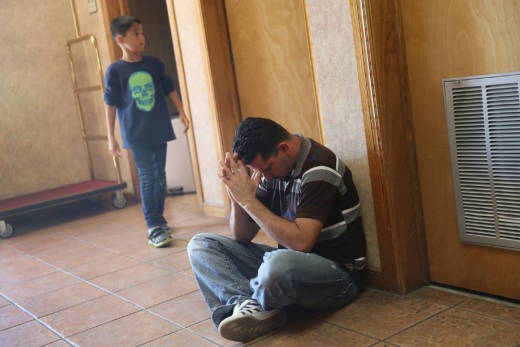A top official with U.S. Department of Health and Human Services is defending his agency’s efforts to identify migrant children separated from parents at the border — and the agency’s narrow definition of which children must be accounted for under a federal judge’s order.
In a court declaration filed Friday, Jonathan White, a commander with the U.S. Public Health Service Commissioned Corps who is leading HHS’s efforts to reunify separated families, said his team had identified all the separated children in the custody of the Office of Refugee Resettlement, part of HHS, as of June 26, 2018. That’s the date U.S. District Judge Dana Sabraw issued an injunction to stop family separations and ordered the government to promptly reunite children with their parents.
Sabraw’s order came in a class action lawsuit — Ms. L vs. U.S. Immigration and Customs Enforcement — which challenged the Trump administration over family separation.
White said in his declaration that the total number of children his agency was responsible for returning to their families is 2,816.
That’s an increase over previous tallies.
In July 2018, ORR reported that there were 2,654 affected children. Officials later revised the number to 2,737. The vast majority of those children have since been released to their parents or another close relative.
But last month, the inspector general for HHS issued a watchdog report, which found that thousands of additional children may have been taken from their parents at the border beginning in 2017, "before the accounting required by the court."
Sabraw asked the government to respond to the inspector general’s report, which states, "Public attention has focused largely on children separated from their parents who are covered by a widely reported federal court order. But, more children, over a longer period of time, have been separated from their parents or guardians and referred to the Office of Refugee Resettlement (ORR) for care."
Attorneys with the American Civil Liberties Union, which is representing plaintiff parents in the Ms. L case, say the government should be held accountable for the earlier separations — and ensure that all those children are also returned to their parents.
“We believe that even if the family were separated and the children were released from U.S. custody before June 26, those families should be included,” said Lee Gelernt, the lead attorney in the case.
“What we suspect is that many parents believed that the only way to get their child out of government custody was to agree to allow the child to be sent to a foster family or some other sponsor ... And we have no idea if those parents have now gotten their children back or not.”
But in his declaration, White said it was unfeasible to try to account for children who had been separated from parents and then released by ORR prior to the June injunction.
“HHS has no statutory authority over discharged children, much less routine contact with all of them,” he wrote. “ORR grantees would face significant hurdles if they tried to collect information from separated children who were discharged before June 26, 2018.”
White said that over the past year and a half, close to 90 percent of unaccompanied or separated children released from ORR were placed with a parent or close relative. So he reasoned that any children separated in 2017 were most likely with their families now.
Even if it were possible to locate previously separated children, White stated that HHS lacks the authority to take a child back from a sponsor in order to reunite the child with their parent. White, a social worker, warned that doing so would “destabilize” the child’s environment and could be traumatic to the children.
“The option more consistent with the best interest of the child,” he asserted, “would be to allow the child to remain with their sponsor and focus instead on the ongoing work of reunifying parents with separated children presently in ORR care.”
The ACLU’s Gelernt called that answer horrific.
"It can't be that we can't account for thousands of children who were separated just because it may be too much work," Gelernt said.
"The Trump administration’s response is a shocking concession that it can't easily find thousands of children it ripped from parents, and doesn't even think it's worth the time to locate each of them."
Gelernt has asked Judge Sabraw to include any child taken from a parent since 2017 in the Ms. L. case. The court is expected to hear that motion later this month.

